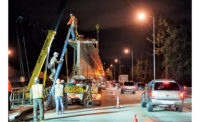If speed-enforcement cameras prompt drivers to slow down, how many people would argue against them? As it turns out, plenty. And they are complicating the challenge of road construction accidents and safety in states in which prohibitions on such cameras don’t exclude road-work zones. With most states yet to deploy such systems or pass laws governing their use, the anti-camera sentiment could be a major impediment.
Illinois, which first allowed speed-radar enforcement in 2004, limits the use of cameras to issue speeding tickets for violations in construction zones and toll roads, according to the Governors’ Highway Safety Association. In 2010, research showed that work-zone cameras slowed cars and trucks by 3 to 8 mph, cut the percentage of speeding vehicles and reduced fatal crashes. Other states followed Illinois’ lead. The state’s speed-enforcement cameras “are doing a good job. They’re sending the right message,” says Bill Frey, executive director of the Associated General Contractors of Illinois. “The public doesn’t realize it’s for their safety. We’re not out to get them.”
Over the past 15 years, a combination of work-zone risk-management initiatives has helped to reduce the number of work zone traffic accidents in the U.S. to 669 people in 2014 from 1,026 in 2000, according to data posted on the website WorkZoneSafety.org. The methods include planning, signage, traffic control, speed-limit enforcement and driver education.
Over those years, research has filled in the statistical picture about the sources of danger. Younger and older drivers tend to speed more than middle-aged motorists, a recent study of Minnesota drivers has shown. And other studies have demonstrated that heavy trucks are involved in about a third of all work-zone fatalities. Last month, six people died in a five- vehicle crash along Interstate 80 near Lexington, Neb., when a distracted truck driver rear-ended a minivan in what the local newspaper described as a “head-to-head” crossover construction zone. Charged with numerous violations, the driver allegedly entered a 9-mile-long work zone where the speed limit was reduced to 65 mph from 75 mph.
Banned in 14 States
Automated highway radar-camera systems would seem to be a logical step. But 14 states have banned them, although some of those states make exceptions for work zones and schools.
Associations that advocate for drivers and their rights have mostly bad things to say about cameras. They claim the cameras end up being government cash cows, generate false readings, are prone to error, deprive drivers of basic rights and actually can make highways and roads more dangerous. The Maryland Drivers Alliance’s assessment was that the safety benefits have been mixed, citing a U.K. study that the alliance claimed demonstrated “that speed cameras did not reduce accident rates in highway work zones.” In general, radar-camera systems enrich suppliers and contractors involved in providing equipment, the alliance claims on its website.
A better strategy, drivers groups say, would be to hire more state troopers to watch work zones. Yet patrol cars in work zones may be limited by the nature of the construction to sitting in only certain places and may not have room to pull drivers over.
Whether the cameras help is not a purely academic question for the driving public. Roughly 85% of the victims of work-zone accidents are drivers and passengers.
Of the seven states that allow radar-camera systems in work zones—Colorado, Illinois, Louisiana, Maryland, Oregon, Tennessee and Washington—not all have put cameras to use. Fines differ, too. Washington state collects $137 for a first violation. In Illinois, an initial violation will earn a $375 penalty, according to presentations by state officials.
In Pennsylvania, two state senators have proposed a five-year pilot program. One of them, David G. Argall (R), said in an email statement that several highway construction workers and their families had asked for stronger safety incentives in work zones.
Simply increasing work-zone length or lowering speed limits won’t do the job, says James Baron, a spokesman for the American Traffic Safety Services Association, a Fredericksburg, Va.-based association of road-safety-related manufacturers and service providers. Because work zones come in so many different types and move with the work progress, stretching out the zone and further lowering speed limits isn’t a good idea, he says.
Human nature presents obstacles, too. Drivers tend to ignore the signs and warnings and proceed at speeds that they feel comfortable driving, explains Jawad Paracha, the Federal Highway Administration’s program manager for work-zone management.
A better approach would be to install intelligent systems that connect to message boards and change as sensors feed in new data about weather, time of day, traffic conditions and new surroundings, Baron says.
Research Backs Camera Use
One of the most controversial radar- camera speed-enforcement programs, Maryland’s SafeZones initiative, in 2009 issued almost 8,800 tickets in its first six weeks.
In a document on the Maryland State Highway Administration’s website, the department claims that SafeZones cut by 80% the number of cars exceeding the speed limit by 12 mph in work zones. It also states that, of almost 1 million citations issued by SafeZones cameras, only two tickets were refunded because they were issued in error.
State officials claim the cameras have a 95% rate of capturing legible photos of speeder license plates, but that wasn’t always the case. A state audit in 2012 found that SafeZones cameras failed to capture clear enough photos of speeders’ license plates, so only 44% of cars caught speeding by the cameras received tickets. The office estimated that the lost revenue from those uncalibrated cameras was at least $850,000.
The state’s original request for proposals to install cameras and collect fines required cameras that could capture legible photos of license plates 95% of the time. That number was reduced to 90% while the state considered bids for the contract to install the cameras and collect the fines.
In February, state senators suggested repealing the right to use cameras. Now, the program’s fate remains uncertain.
For the most part, research supports camera use in work zones. A 2010 Oregon study found that photo radar enforcement “has a substantial impact on reducing the number of speeding vehicles in a construction work zone,” resulting in speeds decreased by 23.7% on average. After the camera was removed, drivers resumed their usual speeds, and signage and workers’ presence “did not have an observable effect on speeding.”
Similar studies in North Carolina and Arizona found decreases in crashes and average speed from both mobile-camera enforcement and fixed-camera enforcement. The 2009 Arizona study showed that crashes during non-peak traffic periods decreased by 44% to 54% and average speed decreased by 9 mph.
Using a driving simulator and eye-tracking glasses, a 2016 experiment in Minnesota examined whether “Your Speed Is”-type signs—often used in tandem with cameras—distracted drivers. The experiment found that the speed display signage was not a significant distraction.
Despite the supporting research, state lawmakers are likely to tread carefully when it comes to speed cameras.
When Indiana considered a camera speed-enforcement bill last year, opponents worried whether the absence of real-time police review of the camera footage would violate due process and whether camera vendors would receive income per ticket issued. One thing seems certain: Radar speed- enforcement systems will need champions who can make the case that work-zone cameras aren’t a new kind of speed trap but are a vital protection to drivers themselves.







Post a comment to this article
Report Abusive Comment